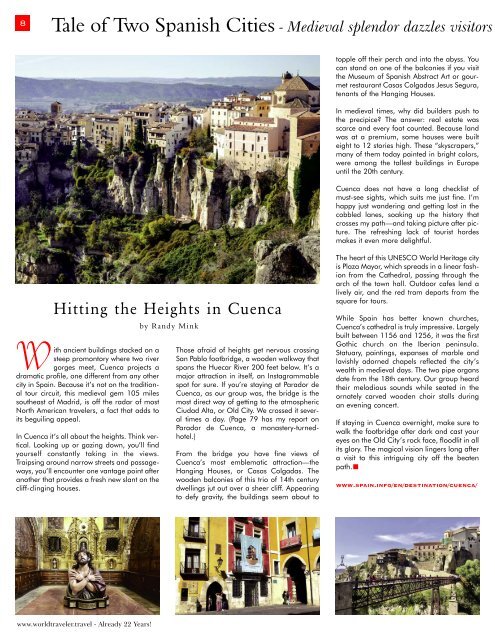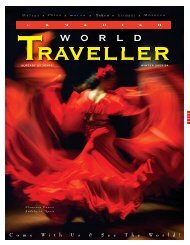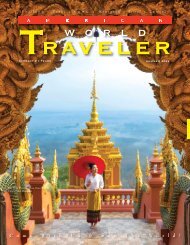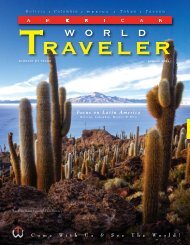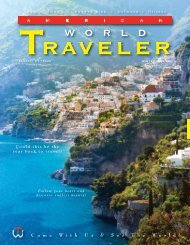Canadian World Traveller Spring 2024 Issue
Now in our 22nd year of publishing, World Traveler explores the culture and history of worldwide destinations, sharing the adventure of discovery with our readers and motivating them to make their travel dreams a reality. World Traveler helps sophisticated, independent travelers choose their next destination by offering a lively blend of intelligent, informative articles and tantalizing photographic images from the world’s best destinations, cruises, accommodations and activities to suit every traveler's taste.
Now in our 22nd year of publishing, World Traveler explores the culture and history of worldwide destinations, sharing the adventure of discovery with our readers and motivating them to make their travel dreams a reality. World Traveler helps sophisticated, independent travelers choose their next destination by offering a lively blend of intelligent, informative articles and tantalizing photographic images from the world’s best destinations, cruises, accommodations and activities to suit every traveler's taste.
You also want an ePaper? Increase the reach of your titles
YUMPU automatically turns print PDFs into web optimized ePapers that Google loves.
8<br />
Tale of Two Spanish Cities - Medieval splendor dazzles visitors<br />
topple off their perch and into the abyss. You<br />
can stand on one of the balconies if you visit<br />
the Museum of Spanish Abstract Art or gourmet<br />
restaurant Casas Colgadas Jesus Segura,<br />
tenants of the Hanging Houses.<br />
In medieval times, why did builders push to<br />
the precipice? The answer: real estate was<br />
scarce and every foot counted. Because land<br />
was at a premium, some houses were built<br />
eight to 12 stories high. These “skyscrapers,”<br />
many of them today painted in bright colors,<br />
were among the tallest buildings in Europe<br />
until the 20th century.<br />
Cuenca does not have a long checklist of<br />
must-see sights, which suits me just fine. I’m<br />
happy just wandering and getting lost in the<br />
cobbled lanes, soaking up the history that<br />
crosses my path—and taking picture after picture.<br />
The refreshing lack of tourist hordes<br />
makes it even more delightful.<br />
Ijuujoh!uif!Ifjhiut!jo!Dvfodb<br />
With ancient buildings stacked on a<br />
steep promontory where two river<br />
gorges meet, Cuenca projects a<br />
dramatic profile, one different from any other<br />
city in Spain. Because it’s not on the traditional<br />
tour circuit, this medieval gem 105 miles<br />
southeast of Madrid, is off the radar of most<br />
North American travelers, a fact that adds to<br />
its beguiling appeal.<br />
In Cuenca it’s all about the heights. Think vertical.<br />
Looking up or gazing down, you’ll find<br />
yourself constantly taking in the views.<br />
Traipsing around narrow streets and passageways,<br />
you’ll encounter one vantage point after<br />
another that provides a fresh new slant on the<br />
cliff-clinging houses.<br />
by Randy Mink<br />
Those afraid of heights get nervous crossing<br />
San Pablo footbridge, a wooden walkway that<br />
spans the Huecar River 200 feet below. It’s a<br />
major attraction in itself, an Instagrammable<br />
spot for sure. If you’re staying at Parador de<br />
Cuenca, as our group was, the bridge is the<br />
most direct way of getting to the atmospheric<br />
Ciudad Alta, or Old City. We crossed it several<br />
times a day. (Page 79 has my report on<br />
Parador de Cuenca, a monastery-turnedhotel.)<br />
From the bridge you have fine views of<br />
Cuenca’s most emblematic attraction—the<br />
Hanging Houses, or Casas Colgadas. The<br />
wooden balconies of this trio of 14th century<br />
dwellings jut out over a sheer cliff. Appearing<br />
to defy gravity, the buildings seem about to<br />
The heart of this UNESCO <strong>World</strong> Heritage city<br />
is Plaza Mayor, which spreads in a linear fashion<br />
from the Cathedral, passing through the<br />
arch of the town hall. Outdoor cafes lend a<br />
lively air, and the red tram departs from the<br />
square for tours.<br />
While Spain has better known churches,<br />
Cuenca’s cathedral is truly impressive. Largely<br />
built between 1156 and 1256, it was the first<br />
Gothic church on the Iberian peninsula.<br />
Statuary, paintings, expanses of marble and<br />
lavishly adorned chapels reflected the city’s<br />
wealth in medieval days. The two pipe organs<br />
date from the 18th century. Our group heard<br />
their melodious sounds while seated in the<br />
ornately carved wooden choir stalls during<br />
an evening concert.<br />
If staying in Cuenca overnight, make sure to<br />
walk the footbridge after dark and cast your<br />
eyes on the Old City’s rock face, floodlit in all<br />
its glory. The magical vision lingers long after<br />
a visit to this intriguing city off the beaten<br />
path.<br />
www.spain.info/en/destination/cuenca/<br />
www.worldtraveler.travel - Already 22 Years!


